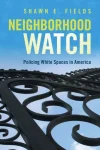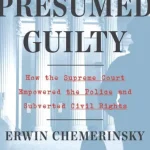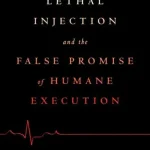Neighborhood Watch: Policing White Spaces in America
 Author: Shawn E. Fields
Author: Shawn E. Fields
Publisher: Cambridge University Press, 2022. 202 pages.
Reviewer: Daanika Gordon| March 2023
Neighborhood Watch: Policing White Space in America, by Shawn E. Fields, opens with a description of events that unfolded on May 25, 2020. This date would come to mark the onset of a nationwide reckoning with anti-Black racism in the United States, as millions watched George Floyd die under a police officer’s knee. The lead up to George Floyd’s murder began when a convenience store clerk called the police on the suspicion that Floyd had used of a counterfeit twenty-dollar bill. But this is not the story that opens Neighborhood Watch. Twelve hours earlier, Christian Cooper’s birdwatching excursion in Central Park was cut short when Amy Cooper, a White woman of no relation, responded to Christian’s request that she leash her dog by calling the police to report ‘an African American man’ threatening her. Fields draws a throughline between the day’s events in the Bramble of Central Park and those that unfolded in Minneapolis. Both began with a 911 call about ‘suspicious’ or ‘threatening’ Black Americans engaged in mundane behavior. Though Christian Cooper was spared a police encounter, the murder of George Floyd reminds us that calls summoning the police to regulate Black people always carry the potential for lethal violence.
Fields argues that private White actors are so unsettled by the mere presence of a Black person or people in a White space—whether a neighborhood or a professional field—that they are quick to summon the police or engage in vigilante policing themselves. Indeed, Neighborhood Watch lists dozens of examples of White callers reporting Black people to the police for engaging in everyday activities, like barbequing in a park, sitting in a Starbucks, napping in a college dormitory, or leaving an AirBnB. This attention to race-out-of-place reflects deeply engrained and often unconscious racial fear that has been baked into the American experience. Private White actors weaponize their racial fear through various methods that rely on the criminal justice system, supported by a legal infrastructure that osters anemic Fourth Amendment protections and is riddled with Stand Your Ground laws and qualified immunity for law enforcement. Ultimately, the weaponization of racial fear serves to further define and enforce the boundaries of the de facto color line. Given the engrained and enduring nature of racial fear, Fields argues that reducing racially violent policing cannot be accomplished through implicit bias trainings or improving the quality of police-civilian interactions. The solution instead lies in limiting the quantity of interactions, particularly those stemming from racist and frivolous 911 calls.
The entrenched nature of racial fear is a foundational premise of Neighborhood Watch. Fields traces the evolution of powerful associations between Blackness, criminality, and violence that have been deployed to justify slavery, Jim Crow, mass incarceration, and ghettoization. These tropes emerge through a cycle in which White elites mischaracterize natural resistance to inhumane conditions as threatening and inherently racial. Myths like the ‘Black bogeyman’ and the ‘superpredator’ then go on to motivate new methods of racial control. Fields argues that generations of messaging have engrained racial fear in the nation’s collective consciousness and into our individual psyches in the form of immovable implicit bias. This fear motivates racial policing by increasing scrutiny of Black people, who today have greater access to traditional spaces of privilege and power. At the same time, racial fear also resists common interventions like implicit bias trainings. The immediate harms posed by the weaponization of racial fear, on the one hand, and the likelihood that racial fear will persist for generations, on the other, set the stage for Fields’ analysis of the private policing of White space and corresponding solutions.
Private White actors weaponize their racial fear in several ways. Of primary interest in Neighborhood Watch is the phenomenon of ‘White caller crime’—the all-to-often demonstrated tendency to call 911 on Black people doing everyday activities. White callers use the police to enforce the color line amid gentrification and the racial integration of professional spaces. 911 abuse also stems from ‘broken windows’ assumptions that minor infractions and nuisances will lead to more serious crimes. This was the case in a 2018 incident when a Subway employee called the police to report a Black family potentially putting soda in water cups, later stating that she assumed they might rob her. No matter the mundanity of the activity, most police departments require dispatch of an armed officer to any ‘criminal’ event in progress. As the tragic killing of 12-year-old Tamir Rice illustrates, these frivolous and racially motivated 911 calls bring with them the potential for deadly force.
The use of policing and police violence to regulate racial space finds various forms of state support. Supreme Court precedent has eroded Fourth Amendment protections by lowering the legal standard for police stops and seizures from probable cause to reasonable suspicion. This standard is notoriously easy to meet, as assessments of ‘reasonableness’ defer to police officers’ experience, training, and discretion. Permissive court standards have intersected with aggressive policing strategies, like broken windows policing, to empower officers to target and detain people for nearly any reason. When police encounters result in deadly violence, additional legal protections ensure that officers are rarely found to have used excessive force. Standards outlined in Graham v. Connor define the reasonableness of a use of force as what a police officer on the scene would have believed during a split-second judgement, again deferring to officers’ experience and testimony. Even in cases of excessive force, officers are shielded from civil liability by qualified immunity, which sets a nearly impossible bar for plaintiffs by requiring them to show that a ‘reasonable officer’ would have known they were violating a ‘clearly established’ right. This legal infrastructure sustains what Fields describes as maximum policing: “a ubiquitous and dangerous approach to policing that calls on officers and departments to pursue, investigate, and arrest as much as resources will allow, and to do it as aggressively and violently as the law will allow” (136).
Some White actors bypass the police and take matters into their own hands. Vigilantes weaponize racial fear by using lethal force to end Black lives, including those of Brennan Walker, Ahmaud Arbery, and Trayvon Martin. Again, the actions of killers often find state support. Proliferating Stand Your Ground legislation has eroded the duty to retreat included in traditional self-defense laws and expanded the scope of the castle doctrine, allowing the use of deadly force in public spaces even when it could be safely avoided. Some states go as far as permitting private citizens to shoot to stop a fleeing felon. Racial biases enter in and through permissive laws. Determinations of whether the fear of White vigilantes was ‘objectively reasonable’ are colored by shared assumptions of Black criminality. The persistence of segregated urban and suburban spaces triggers suspicion of Black people in White space. As Fields summarizes, “the natural consequence, if not the intent, of these laws is to sanction the forcible segregation of public spaces into ‘us’ and ‘them’ spaces and authorize the violent enforcement of invisible property lines, by those who belong against the suspiciously out-of-place” (92).
Ultimately, Fields argues that protecting Black lives from the violence of private policing requires minimizing opportunities for police-civilian contact. One set of interventions targets racist 911 abuse through model legislation that aims to deter and punish callers and enhancing the discretion of dispatchers and police officers to ignore frivolous and racially motivated calls. Other solutions lie in dismantling the legal foundations of maximum policing: repealing Stand Your Ground laws, creating legislation to raise the standard for objectively reasonable uses of deadly force, changing police policy to prioritize de-escalation, empowering independent prosecutors to investigate police misconduct, and ending qualified immunity for both the police and municipal governments that oversee them. Beyond legal changes, alternative models of emergency response to many kinds of situations that do not require police can limit the potential for violence. Finally, Fields calls upon readers to mobilize and vote to challenge the White space of American politics and lay the groundwork for large-scale legislative change.
Neighborhood Watch offers novel and compelling insights into racialized policing through its focus on the demand side of police contacts. Researchers, organizers, and lawmakers often home in on proactive police activities—like investigatory traffic stops and stop-and-frisk—in efforts to analyze and mitigate racial violence. But the reality, as Fields notes, is that most police interactions with civilians are reactive. Many aspects of policing are shaped by public demand. The careful analysis in Neighborhood Watch highlights the underexplored role of private actors in leveraging public resources like the police to regulate space. The racial violence of policing is not merely a problem of the state; it reflects the fears and desires of the White American public.
The analysis in Neighborhood Watch invites future investigations into the book’s major themes. How do dynamics of racial fear, racist 911 abuse, and state-sanctioned police and vigilante violence operate within and across the experiences of other racialized communities in the United States? Anti-Black implicit bias is pervasive and not circumscribed to the subconsciouses of Whites, and policing has been leveraged to violently regulate other racial groups. Future investigations can offer complementary insights that build out a picture of the patterns and contingencies of private policing in a multi-racial society. The thorough account of the historical development and current manifestations of anti-Black racial fear and implicit bias may also create opportunities to theorize what Fields describes as a multi-generational project of reprogramming the nation’s psyche. Beyond its many insights into the private policing of Black Americans and near-term interventions, Neighborhood Watch generates new questions into the creation, maintenance, and change of the US racial order.
Readers in many fields will appreciate Fields’s lucid writing and argumentation. Neighborhood Watch draws on clear legal analysis and evocative narratives of specific cases throughout. For instance, the chapter on White caller crime features transcripts of 911 calls and sensitive retelling of individual stories to illustrate just how racist, dangerous, and common the phenomenon is. This chapter is a must-read, particularly for those who might write off such incidents as anomalous or merely inconvenient. Chapters on proposed solutions draw on examples of promising reforms, new programs, and model legislation from across the country. These are just some of the attributes that makes Neighborhood Watch an essential resource for legal scholars and practitioners, academics across a variety of disciplines, and anyone with an interest in understanding the historical and contemporary linkages between racism, segregation, and policing.
Daanika Gordon is an Assistant Professor of Sociology at Tufts University.


